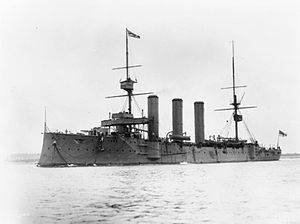 Essex at anchor
| |
| History | |
|---|---|
| Name | Essex |
| Namesake | Essex |
| Builder | HM Dockyard, Pembroke, Wales |
| Laid down | 2 January 1900 |
| Launched | 29 August 1901 |
| Completed | 22 March 1904 |
| Fate | Sold for scrap, 8 November 1921 |
| General characteristics | |
| Class and type | Monmouth-class armoured cruiser |
| Displacement | 9,800 long tons (10,000 t) (normal) |
| Length | 463 ft 6 in (141.3 m) (o/a) |
| Beam | 66 ft (20.1 m) |
| Draught | 25 ft (7.6 m) |
| Installed power |
|
| Propulsion | 2 × shafts; 2 × triple-expansion steam engines |
| Speed | 23 knots (43 km/h; 26 mph) |
| Complement | 678 |
| Armament |
|
| Armour |
|
HMS Essex was one of 10 Monmouth-class armoured cruisers built for the Royal Navy in the first decade of the 20th century. Upon completion in 1904 she was assigned to the 2nd Cruiser Squadron of the Channel Fleet. The ship was placed in reserve in March 1906 and recommissioned in 1909 for service with the 4th Cruiser Squadron on the North America and West Indies Station. In 1912, Essex returned home and was assigned to the Training Squadron of the Home Fleet. After a refit the following year, she rejoined the 4th Cruiser Squadron in early 1914.
After the beginning of World War I in August, the ship captured a German merchantman the following month. Essex spent most of the first half of the war in the Atlantic Ocean, escorting convoys and searching for German commerce raiders. The ship captured another German merchantman in mid-1916 and was reduced to second-line roles such as depot ship and accommodation ship a few months later. She was paid off in 1919 and sold for scrap two years later.